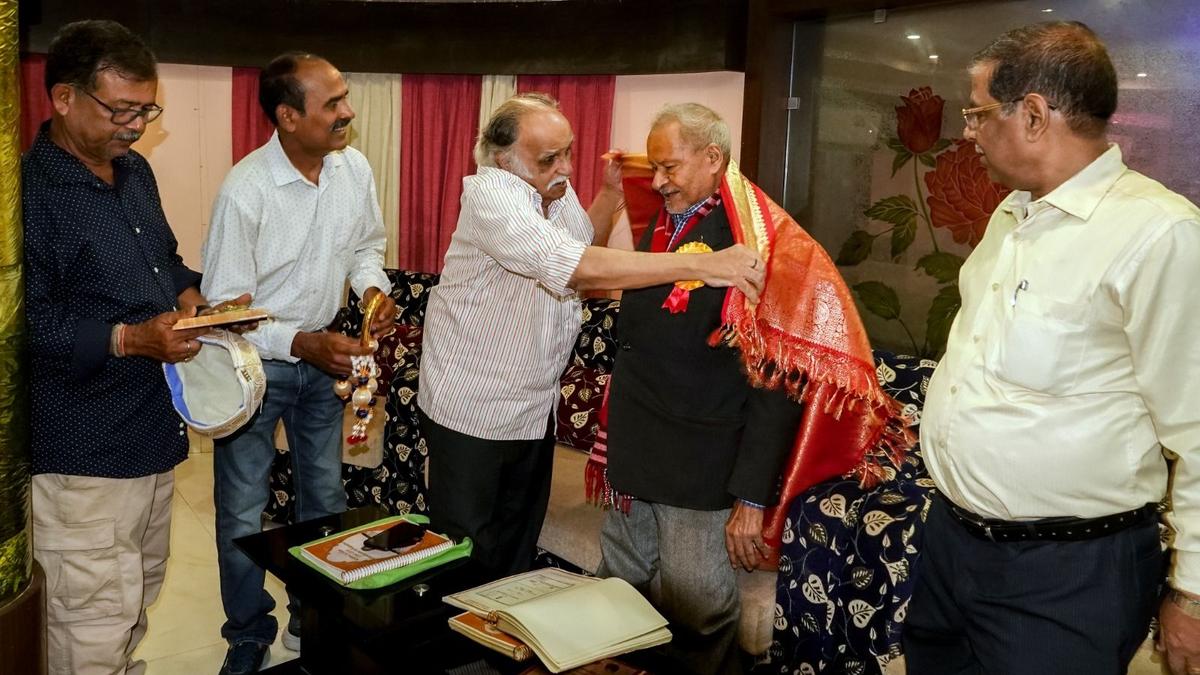November 2023 marked the beginning of the centenary celebrations for cinematographer, VK Murthy. As part of the year-long celebrations, senior students of SJ Polytechnic College, Bengaluru, led by veteran cinematographer, BS Basavaraj, felicitated three cinematographers — Dilip Dutta, Srinivas Mahapatra and Ghanashyam Mahapatra.
The three cinematographers were students of one of the first few batches of SJP. Ghanashyam was conferred the Jaydev Purashkar for his contribution to Odiya films.
Basavaraj, who has worked with directors including Puttanna Kanagal, says, “Our seniors have contributed greatly to cinema. Since we all are alumni of SJP, we wanted to felicitate them.”
A group of ex-alumni travelled to Odisha as Ghanashyam and Srinivas are based there. Dilip joined the group from Mumbai. Basavaraj, who is a Rajyotsava Award winner from the 1980 batch of SJP, says, “At SJP, they taught us cinematography, direction and screenplay writing. We learnt every aspect of filmmaking.”
In a similar vein, Basavaraj says, a student of photography would be taught printing, and editing. “We even had a film appreciation course so we would be adept at everything related to cinema.”
Dilip, Basavaraj says, joined Filmistan Studios in Mumbai as an associate director just like VK Murthy, who hailed from Mysuru and moved to Mumbai. “Murthy worked in only one Kannada film, Hoovu Hannu (1993), directed by Rajendra Singh Babu, while his contributions have been massive in Hindi cinema instead.”
This is because those days, Basavaraj says, cinematographers were hired by studios and given a monthly salary. “Murthy was tied to Guru Dutt’s production house and worked extensively with him. Things only changed post 1980, when working for a film was on contract basis.”
Before this Basavaraj says, everyone from the lead actor to cinematographers and music directors were employed by studios. “Earlier, a film would take at least two to three years to be completed. Mughal-e-Azam took over 10 years to complete.”
In Chennai too, Basavaraj says, films were produced by studios such as AVM or Gemini. “Today, if you have money, you can become an independent filmmaker and choose your team and actors.”
Murthy was a student of the first batch of students from SJP, Basavaraj says. “Srinivas was from the 1961 batch, he moved to Mumbai to work in Hindi and Odiya feature films as well as documentaries. Srinivas worked with stars and actors including Mala Sinha, Meena Kumari, Saira Banu, Sharmila Tagore, Neetu Singh, Shabana Azmi, Joy Mukherjee, Rajesh Khanna, Sunil Dutt, Raj Kapoor, Shammi Kapoor, Shashi Kapoor and Dharmendra.”
Dilip Dutta receiving the special VK Murthy memento
| Photo Credit:
Special Arrangement
Celebrating VK Murthy centenary, Basavaraj says, was an opportunity to meet their seniors. “Srinivas was the most emotional. Dilip, who is from the 1963 batch, moved to Mumbai and worked in Hindi, Bhojpuri, Marathi, Odiya films. He made documentaries for the Odisha Government and Indian Film Division.”
Dilip is still working in Mumbai and his sons too have become cinematographers, Basavaraj says. “Choti Si Mulakat, Bazaar, Platform, Baazigar, and Aap Aaye Bahaar Ayee are some of the films he worked in. Dilip is in his ‘90s and plans to visit SJP and revisit his hostel room and classrooms as he says he has fond memories of the place.”
Dilip has worked on documentaries including Weavers of Sambhalpur, A Grain Saved A Grain Produced and Wood Carvings of Orissa, which were released through Films Division.
S Visveswarappa, a photographer to Chief Ministers from Deve Gowda to Basavaraj Bommai, is also a senior student of SJP. “When I wanted to study photography at SJP, my friends and family were sceptical. It was only when I came to SJP, I discovered how vast the world of creativity was. While I did not work in film, I did take photography seriously.”
Felicitating seniors seemed apt, Visveswarappa says. “When we studied at SJP, it was all theory. Practical lessons happened only when we went on the field. With these limitations they have achieved a lot and it is an honour for us to be associated with the same college as them”.
Srinivas Mahapatra with SJP alumnis
| Photo Credit:
Special Arrangement
Ramasagara Nanjunda Shivarama Reddy, also an ex alumni of SJP, studied cinematography. “Govind Nihalani and Basavaraj were my seniors. I am floored by all that Ghanashyam has achieved. He was in SJP from 1955 to 1958. He came from Odisha as in those days SJP was considered a pioneer in film studies.”
Despite Ghanashyam winning accolades in Hindi films, Reddy says, Ghanashyam decided to set base in Odisha and make films that promoted Odiya culture. “He made films for the health department and started a production house — Konarak Films Pvt Limited in 1960.”
Ghanashyam is technically sound in every aspect of film making, Reddy says. “This is possible thanks to our training in SJP. He is 95 and still active in cinema. In 1962, he made a documentary called Maa Aur Shisu for the Orissa health Department, which won the Best Documentary Award from the Odisha government in 1975. He later became a member of the All India Panel of The Film Division-Mumbai.”
Ghanashyam made a documentary on Kelucharan Mohapatra and Sanjukta Panigrahi titled Odissi Dance, says Reddy. “This was the first film to be made in Eastmancolor and was screened at the fifth World Film Festival in New Delhi, organised by the India Film Society and the Cultural Department of the then USSR in 1972.”
Published – October 15, 2024 12:21 pm IST
